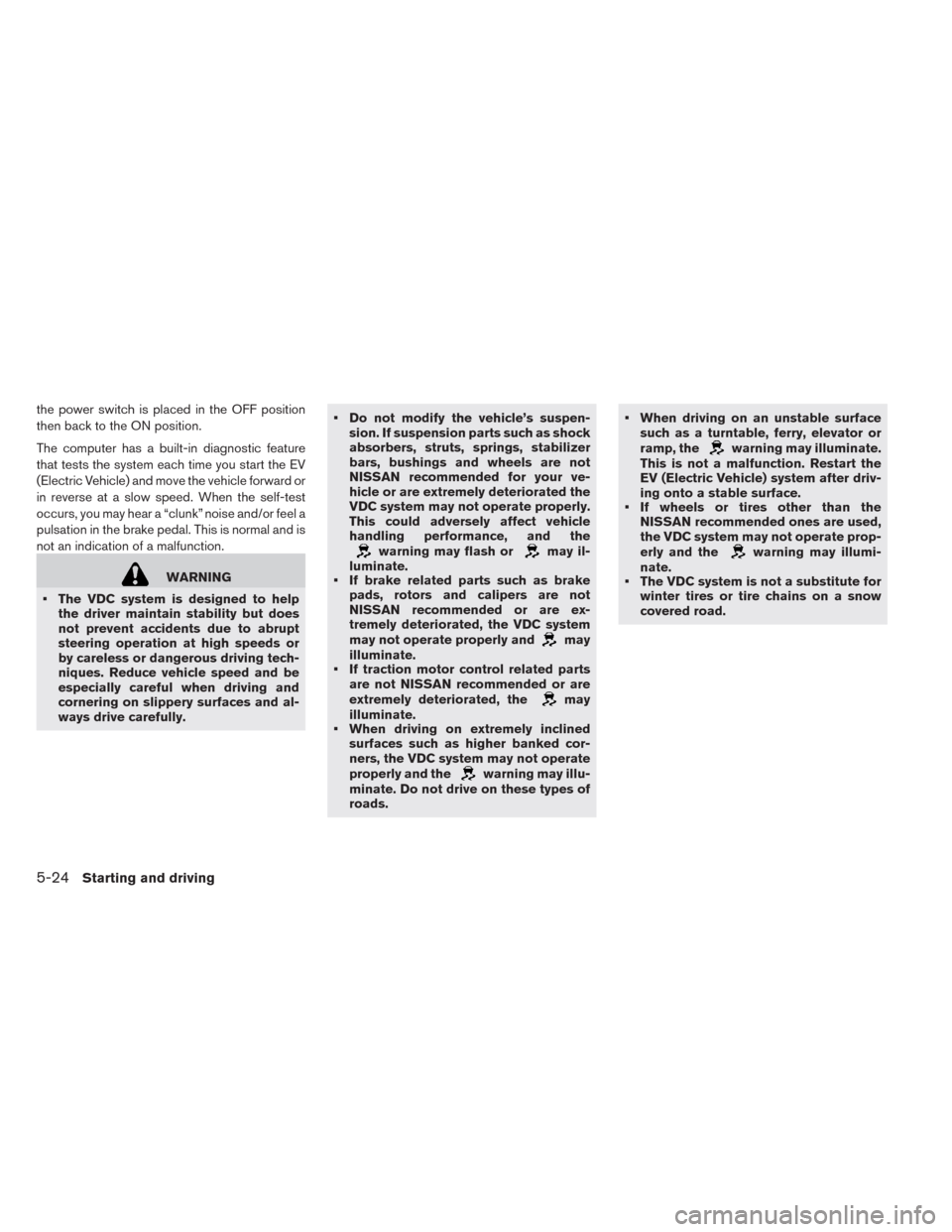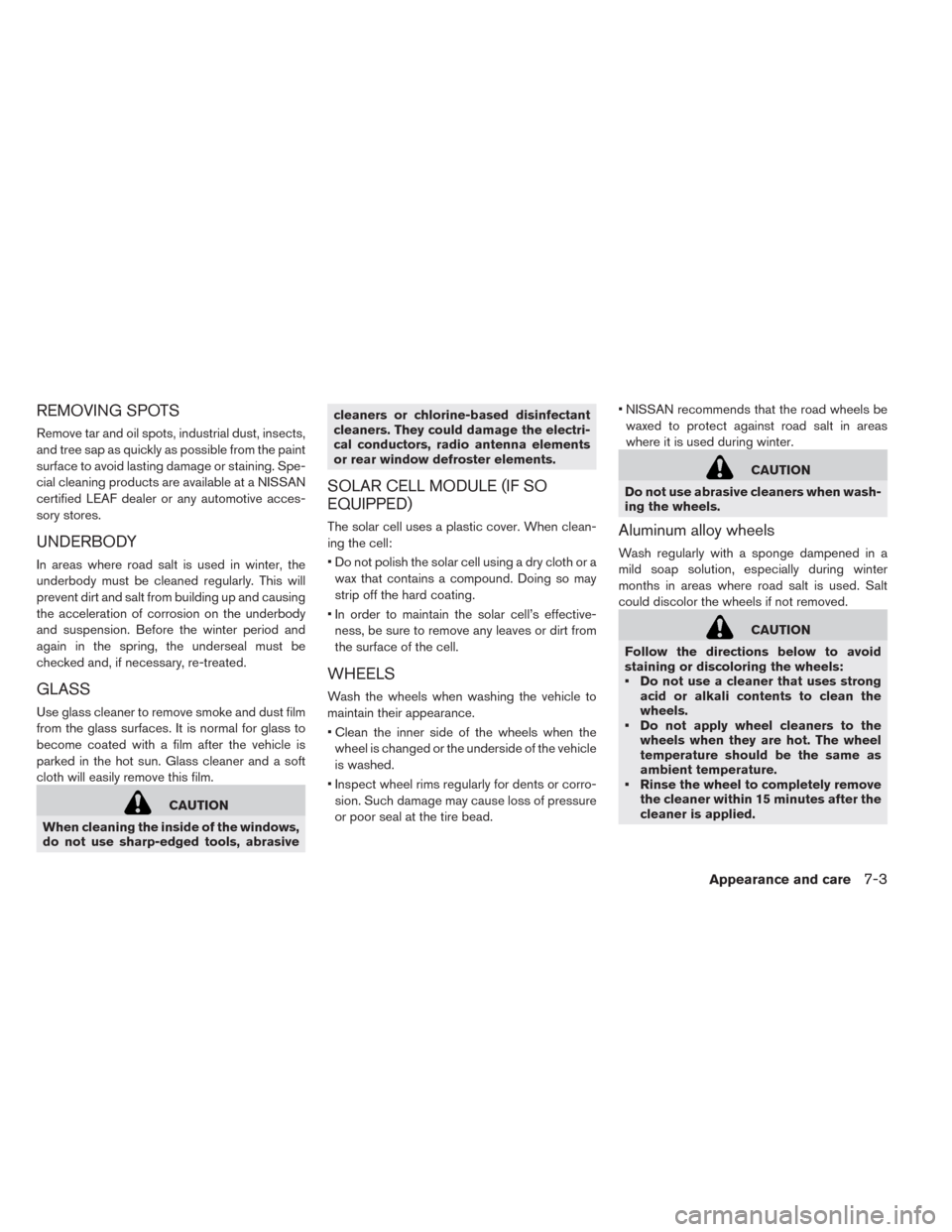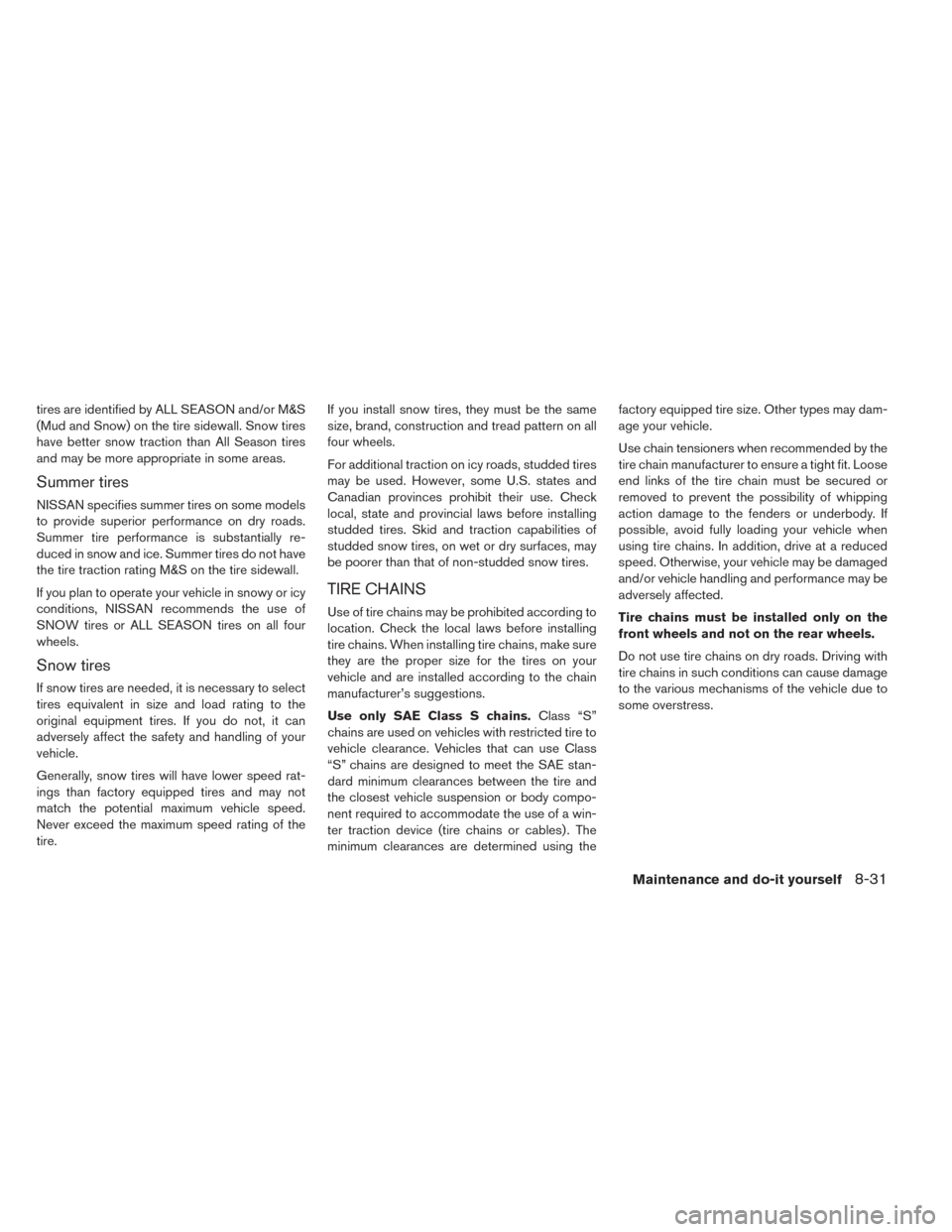2014 NISSAN LEAF suspension
[x] Cancel search: suspensionPage 304 of 397

the power switch is placed in the OFF position
then back to the ON position.
The computer has a built-in diagnostic feature
that tests the system each time you start the EV
(Electric Vehicle) and move the vehicle forward or
in reverse at a slow speed. When the self-test
occurs, you may hear a “clunk” noise and/or feel a
pulsation in the brake pedal. This is normal and is
not an indication of a malfunction.
WARNING
• The VDC system is designed to help
the driver maintain stability but does
not prevent accidents due to abrupt
steering operation at high speeds or
by careless or dangerous driving tech-
niques. Reduce vehicle speed and be
especially careful when driving and
cornering on slippery surfaces and al-
ways drive carefully.• Do not modify the vehicle’s suspen-
sion. If suspension parts such as shock
absorbers, struts, springs, stabilizer
bars, bushings and wheels are not
NISSAN recommended for your ve-
hicle or are extremely deteriorated the
VDC system may not operate properly.
This could adversely affect vehicle
handling performance, and the
warning may flash ormay il-
luminate.
• If brake related parts such as brake
pads, rotors and calipers are not
NISSAN recommended or are ex-
tremely deteriorated, the VDC system
may not operate properly and
may
illuminate.
• If traction motor control related parts
are not NISSAN recommended or are
extremely deteriorated, the
may
illuminate.
• When driving on extremely inclined
surfaces such as higher banked cor-
ners, the VDC system may not operate
properly and the
warning may illu-
minate. Do not drive on these types of
roads.• When driving on an unstable surface
such as a turntable, ferry, elevator or
ramp, the
warning may illuminate.
This is not a malfunction. Restart the
EV (Electric Vehicle) system after driv-
ing onto a stable surface.
• If wheels or tires other than the
NISSAN recommended ones are used,
the VDC system may not operate prop-
erly and the
warning may illumi-
nate.
• The VDC system is not a substitute for
winter tires or tire chains on a snow
covered road.
5-24Starting and driving
Page 327 of 397

REMOVING SPOTS
Remove tar and oil spots, industrial dust, insects,
and tree sap as quickly as possible from the paint
surface to avoid lasting damage or staining. Spe-
cial cleaning products are available at a NISSAN
certified LEAF dealer or any automotive acces-
sory stores.
UNDERBODY
In areas where road salt is used in winter, the
underbody must be cleaned regularly. This will
prevent dirt and salt from building up and causing
the acceleration of corrosion on the underbody
and suspension. Before the winter period and
again in the spring, the underseal must be
checked and, if necessary, re-treated.
GLASS
Use glass cleaner to remove smoke and dust film
from the glass surfaces. It is normal for glass to
become coated with a film after the vehicle is
parked in the hot sun. Glass cleaner and a soft
cloth will easily remove this film.
CAUTION
When cleaning the inside of the windows,
do not use sharp-edged tools, abrasivecleaners or chlorine-based disinfectant
cleaners. They could damage the electri-
cal conductors, radio antenna elements
or rear window defroster elements.
SOLAR CELL MODULE (IF SO
EQUIPPED)
The solar cell uses a plastic cover. When clean-
ing the cell:
• Do not polish the solar cell using a dry cloth or a
wax that contains a compound. Doing so may
strip off the hard coating.
• In order to maintain the solar cell’s effective-
ness, be sure to remove any leaves or dirt from
the surface of the cell.
WHEELS
Wash the wheels when washing the vehicle to
maintain their appearance.
• Clean the inner side of the wheels when the
wheel is changed or the underside of the vehicle
is washed.
• Inspect wheel rims regularly for dents or corro-
sion. Such damage may cause loss of pressure
or poor seal at the tire bead.• NISSAN recommends that the road wheels be
waxed to protect against road salt in areas
where it is used during winter.
CAUTION
Do not use abrasive cleaners when wash-
ing the wheels.
Aluminum alloy wheels
Wash regularly with a sponge dampened in a
mild soap solution, especially during winter
months in areas where road salt is used. Salt
could discolor the wheels if not removed.
CAUTION
Follow the directions below to avoid
staining or discoloring the wheels:
• Do not use a cleaner that uses strong
acid or alkali contents to clean the
wheels.
• Do not apply wheel cleaners to the
wheels when they are hot. The wheel
temperature should be the same as
ambient temperature.
• Rinse the wheel to completely remove
the cleaner within 15 minutes after the
cleaner is applied.
Appearance and care7-3
Page 363 of 397

tires are identified by ALL SEASON and/or M&S
(Mud and Snow) on the tire sidewall. Snow tires
have better snow traction than All Season tires
and may be more appropriate in some areas.
Summer tires
NISSAN specifies summer tires on some models
to provide superior performance on dry roads.
Summer tire performance is substantially re-
duced in snow and ice. Summer tires do not have
the tire traction rating M&S on the tire sidewall.
If you plan to operate your vehicle in snowy or icy
conditions, NISSAN recommends the use of
SNOW tires or ALL SEASON tires on all four
wheels.
Snow tires
If snow tires are needed, it is necessary to select
tires equivalent in size and load rating to the
original equipment tires. If you do not, it can
adversely affect the safety and handling of your
vehicle.
Generally, snow tires will have lower speed rat-
ings than factory equipped tires and may not
match the potential maximum vehicle speed.
Never exceed the maximum speed rating of the
tire.If you install snow tires, they must be the same
size, brand, construction and tread pattern on all
four wheels.
For additional traction on icy roads, studded tires
may be used. However, some U.S. states and
Canadian provinces prohibit their use. Check
local, state and provincial laws before installing
studded tires. Skid and traction capabilities of
studded snow tires, on wet or dry surfaces, may
be poorer than that of non-studded snow tires.
TIRE CHAINS
Use of tire chains may be prohibited according to
location. Check the local laws before installing
tire chains. When installing tire chains, make sure
they are the proper size for the tires on your
vehicle and are installed according to the chain
manufacturer’s suggestions.
Use only SAE Class S chains.Class “S”
chains are used on vehicles with restricted tire to
vehicle clearance. Vehicles that can use Class
“S” chains are designed to meet the SAE stan-
dard minimum clearances between the tire and
the closest vehicle suspension or body compo-
nent required to accommodate the use of a win-
ter traction device (tire chains or cables) . The
minimum clearances are determined using thefactory equipped tire size. Other types may dam-
age your vehicle.
Use chain tensioners when recommended by the
tire chain manufacturer to ensure a tight fit. Loose
end links of the tire chain must be secured or
removed to prevent the possibility of whipping
action damage to the fenders or underbody. If
possible, avoid fully loading your vehicle when
using tire chains. In addition, drive at a reduced
speed. Otherwise, your vehicle may be damaged
and/or vehicle handling and performance may be
adversely affected.
Tire chains must be installed only on the
front wheels and not on the rear wheels.
Do not use tire chains on dry roads. Driving with
tire chains in such conditions can cause damage
to the various mechanisms of the vehicle due to
some overstress.
Maintenance and do-it yourself8-31